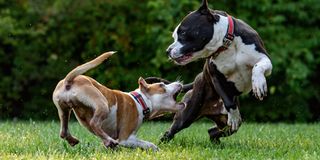Setting up pet-friendly garden in your backyard

What you need to know:
Petscaping is the process by which one prepares their garden to ensure it is safe and fun for pets to access
Having a home garden is something many homeowners take on as a hobby, others to beautify their compounds while a number see it as a way of getting extra food for consumption. However, one has to put a lot into consideration before setting up one, especially if they have pets in the home. The pet could be a rabbit, cat, dog, a bird or even a turtle depending on one’s choice.
“Every home gardener should consider petscaping if they have pets around because it gets difficult to watch over pets all the time. Chances are they will wander into the home garden at some stage,” says Martha Busululwa, a resident of Najjera who has a home garden and two Maltese dogs.
Petscaping is the process by which one prepares their garden to ensure it is safe and fun for pets to access. She says at times the dogs dig up plants or even try to eat some of them. Petscaping, creates an environment where the pets and the home garden can coexist peacefully by getting rid of toxic plants, adding pet-friendly options, hardscaping and including a water feature.
Get rid of toxic plants
It is crucial to eliminate toxic plants from your garden that could accidentally poison pets, thus leading to death. Some of these poisonous plants include azaleas, lilies, rhododendrons, yew, autumn crocus, English ivy, daffodils and tulip bulbs can all kill pets once ingested.
Aaron Etima, a resident of upper Naguru, says he found Juicy, his pet puppy lifeless near their home garden and called in a veterinary officer who concluded that Juicy had succumbed to a poisonous plant.
Watch out for thorny plants
As pets run around your garden, they might hurt themselves as many of them have soft foot pads. Apart from hurting the feet, thorns can also rupture pets’ skins or leave scratches. Roses are a good example of a thorny plant that could harm or inflict pain on a pet.
To protect them, it is advisable to create paths to facilitate their movement without damaging or getting injured by plants. While designing the paths, experts recommend smooth gravel to avoid hurting the pets.
Fence the garden
Use short and small fences to show pets the borders of the garden. “It is better to construct the boundaries out of the same material to help pets recognise them,” says Arthur Mpalanyi who runs a plant nursery in Nakawa.
Fertilisers and pesticides you use
Always read instructions before using any fertiliser or pesticide in your home garden if you have pets at home. Some of them are poisonous and life threatening to pets. In case you must apply poisonous fertilisers or pesticides, keep the pets out of the garden for the recommended amount of time after spraying them. There is also an option of using safer chemicals that might not pose a threat to the pets.
Include a shade and water
Pets such as dogs and cats are not comfortable with heat and therefore, need protection from the sun. They also need access to water in case it is too hot. To help the pets keep hydrated while in the garden, one ought to provide a shade to protect them from direct sun rays on top of having a source of clean water available to help cool them off.
Fight pests
Some of the pests that prey on the plants or flowers can also harm pets. Ticks and fleas which accumulate from garden litter can turn pets into their hosts if the pets access the garden. You can control these by keeping the garden neat and tidy or by use of non-poisonous pesticides. Mow the garden and remove leaves that have shed off as they might attract pests and other insects.
Include a shade and water
Pets such as dogs and cats are not comfortable with heat and therefore, need protection from the sun. They also need access to water in case it is shining too bright. To help the pets keep hydrated while in the garden, one should provide a shade to protect them from direct sunrays on top of having a source of clean water available to help cool them off.




